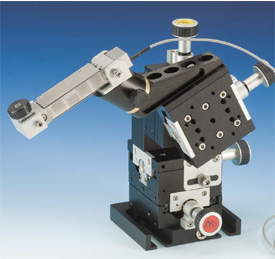Electrophysiological studies require fast motions of a double-bore (theta-glass) pipette across cell membranes. With a cell held in a patch clamp and monitored electrically, one bore of the pipette flows a buffer solution, while the other carries a drug or other chemical. By quickly sweeping the pipette so one bore or the other suffuses the cell, its electrophysiological response can be correlated to the chemical environment.
Piezos are ideal for fast switching, as they offer electromagnetic quietness, good repeatability, high reliability and fast speeds. However, fast acceleration can mean recoil forces excite vibration in the pipette and both piezo and stepper actuators have suffered from these in the past. These cause unwanted, repetitive solution switching for many milliseconds.

Enabling fast sweeps without vibration
Now Siskiyou and PI have collaborated on an approach which can eliminate unwanted switching, yielding crisp, artifact-free data. Siskiyou's MXPZT-300 integrates PI's high-speed flexure guided piezo nanopositioner with a convenient, stable coarse positioning stack. Patented Input Shaping vibration-canceling technology nullifies the repetitive switching. Piezo movement is controlled by input from popular recording amplifier equipment. The MXPZT-300 controller incorporates all electronics and pro-vides connectivity to popular electrophysiological equipment from respected manufacturers.
Test results
A novel test combining motion metrology with synchronous acquisition of electrophysiological signal data vividly illustrates the benefits (Fig. 1). A laser Doppler interferometer was sighted at the tip of the theta-glass pipette while buffer and test solutions flowed and a patch-clamped cell's response was monitored. The picocurrent signal shows a clear and intuitive correlation between motion and signal, showing the unwanted repeti-tive switching is virtually eliminated by the MXPZT-300.